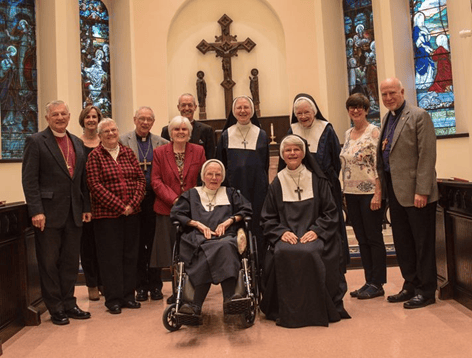LEICESTER, United Kingdom – Following a campaign by art historians, the UK government has added the “Oldham Mural” masterpiece to its national heritage register.
The mural is located in Holy Rosary Church in Oldham – a town in the Greater Manchester area of England. It is one of the most important works of Hungarian artist George Mayer-Marton, who died in 1960.
The church closed in 2017, putting the artwork – called “The Crucifixion” – at risk.
The Jewish artist was a pioneer of the Byzantine mosaic method in England having fled Austria in 1938 after the Anschluss with Nazi Germany. He worked on several churches, especially in the northwest of England, after his arrival in the country. He created “The Crucifixion” – which is over 24 feet long – at Holy Rosary in 1955.
“The George Mayer-Marton mural in Oldham’s Holy Rosary Church is of great importance. The listing recognises this. The Patrimony Committee looks forward to working with Salford Diocese [which covers the greater Manchester area], and all interested parties, to ensure the protection and proper conservation of this outstanding artwork. This is now urgent,” said Sophie Andreae, vice chair of the bishops’ conference’s Patrimony Committee.
The frescos were partially painted over in the 1980s, however, experts say the work is still extant underneath.
Speaking to Crux last year, Clare Willsdon, professor of art history at Glasgow University noted the piece is the only known surviving mural by Mayer-Marton that combines fresco painting and mosaic.
RELATED: Art historians campaign to save rare mosaic in closed UK parish church
“Both the historic facetted ‘Byzantine’ mosaic technique that Mayer-Marton used for the Crucifixion element, and the Italian Renaissance-type ‘true fresco’ that he used for the flanking figures of Mary and John, and the background sky, involve a physical integration of image and building that is very evocative and meaningful in relation to Roman Catholic belief in transubstantiation,” she told Crux.
“For in Byzantine mosaic, which Mayer-Marton learnt in Italy, the mosaic pieces – tesserae – are pressed into the still wet plaster of the wall, whilst fresco similarly involves painting on wet plaster, so that the pigment bonds chemically with the wall as it dries. The images of the crucified Christ and his mourning mother and St. John were thus made symbolically one with the body of the church, and the rituals performed within it – not least of Holy Communion at the altar directly beneath the mural,” Willsdon explained.
The mural is now a Grade II listed building, giving it protection under British law. Listed buildings can’t be demolished or altered without special permission. There are three grades under the law, but the vast majority of listed buildings are Grade II.
The UK’s Heritage Minister, Nigel Huddleston, issued a statement explaining the reason the work was given legal protection.
“This stunning mural in the Church of the Holy Rosary deserves to be listed at Grade II. This will protect the one-of-a-kind mural and serve as an important reminder for future generations of Hungarian artist George Mayer-Marton’s escape from Nazi persecution,” he said.
Mayer-Marton’s nephew, Nick Braithwaite, said he welcomed the listing of his uncle’s artwork.
“I am delighted this masterpiece of exceptional significance is finally receiving the national recognition it deserves. I am grateful to everyone who has helped get us here and especially to SAVE Britain’s Heritage for keeping the mural in the spotlight,” he said.
SAVE Britain’s Heritage was established in the 1970s by journalists, historians, architects, and city planners to campaign publicly for endangered historic buildings, many of which had been destroyed in the UK’s post-war period.
Henrietta Billings, director of SAVE Britain’s Heritage, called the listing of Mayer-Marton’s work “a fantastic result for Oldham, and modern public art in England.”
“We’re delighted that the mural will now be celebrated and finally given the recognition it deserves. Listing will open up a new chapter for this building and artwork and we look forward to helping the Diocese of Salford to find a new and sympathetic owner,” she said.
The diocese has said it is “committed to protecting George Mayer-Marton’s rare work of art and to ensuring that the work is made more accessible to the public going forward.”

















